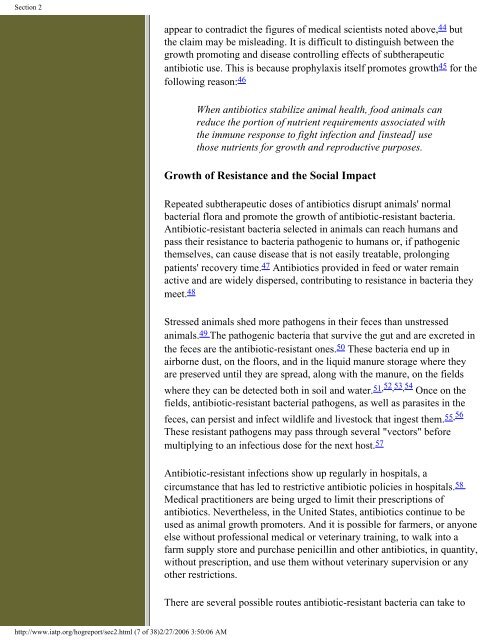IATP Hog Report - Institute for Agriculture and Trade Policy
IATP Hog Report - Institute for Agriculture and Trade Policy
IATP Hog Report - Institute for Agriculture and Trade Policy
You also want an ePaper? Increase the reach of your titles
YUMPU automatically turns print PDFs into web optimized ePapers that Google loves.
Section 2<br />
appear to contradict the figures of medical scientists noted above, 44 but<br />
the claim may be misleading. It is difficult to distinguish between the<br />
growth promoting <strong>and</strong> disease controlling effects of subtherapeutic<br />
antibiotic use. This is because prophylaxis itself promotes growth 45 <strong>for</strong> the<br />
following reason: 46<br />
When antibiotics stabilize animal health, food animals can<br />
reduce the portion of nutrient requirements associated with<br />
the immune response to fight infection <strong>and</strong> [instead] use<br />
those nutrients <strong>for</strong> growth <strong>and</strong> reproductive purposes.<br />
Growth of Resistance <strong>and</strong> the Social Impact<br />
Repeated subtherapeutic doses of antibiotics disrupt animals' normal<br />
bacterial flora <strong>and</strong> promote the growth of antibiotic-resistant bacteria.<br />
Antibiotic-resistant bacteria selected in animals can reach humans <strong>and</strong><br />
pass their resistance to bacteria pathogenic to humans or, if pathogenic<br />
themselves, can cause disease that is not easily treatable, prolonging<br />
patients' recovery time. 47 Antibiotics provided in feed or water remain<br />
active <strong>and</strong> are widely dispersed, contributing to resistance in bacteria they<br />
meet. 48<br />
Stressed animals shed more pathogens in their feces than unstressed<br />
animals. 49 The pathogenic bacteria that survive the gut <strong>and</strong> are excreted in<br />
the feces are the antibiotic-resistant ones. 50 These bacteria end up in<br />
airborne dust, on the floors, <strong>and</strong> in the liquid manure storage where they<br />
are preserved until they are spread, along with the manure, on the fields<br />
where they can be detected both in soil <strong>and</strong> water. 51,52 , 53 , 54 Once on the<br />
fields, antibiotic-resistant bacterial pathogens, as well as parasites in the<br />
feces, can persist <strong>and</strong> infect wildlife <strong>and</strong> livestock that ingest them. 55,56<br />
These resistant pathogens may pass through several "vectors" be<strong>for</strong>e<br />
multiplying to an infectious dose <strong>for</strong> the next host. 57<br />
Antibiotic-resistant infections show up regularly in hospitals, a<br />
circumstance that has led to restrictive antibiotic policies in hospitals. 58<br />
Medical practitioners are being urged to limit their prescriptions of<br />
antibiotics. Nevertheless, in the United States, antibiotics continue to be<br />
used as animal growth promoters. And it is possible <strong>for</strong> farmers, or anyone<br />
else without professional medical or veterinary training, to walk into a<br />
farm supply store <strong>and</strong> purchase penicillin <strong>and</strong> other antibiotics, in quantity,<br />
without prescription, <strong>and</strong> use them without veterinary supervision or any<br />
other restrictions.<br />
There are several possible routes antibiotic-resistant bacteria can take to<br />
http://www.iatp.org/hogreport/sec2.html (7 of 38)2/27/2006 3:50:06 AM

















